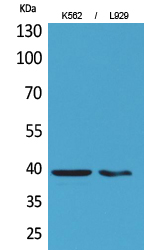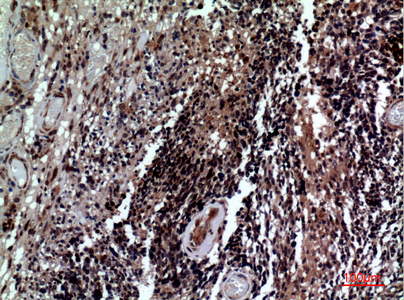产品名称
CD84 Rabbit Polyclonal Antibody
别名
CD84; SLAMF5; SLAM family member 5; Cell surface antigen MAX.3; Hly9-beta; Leukocyte differentiation antigen CD84; Signaling lymphocytic activation molecule 5; CD84
蛋白名称
SLAM family member 5
存储缓冲液
Liquid in PBS containing 50% glycerol, 0.5% BSA and 0.02% New type preservative N.
Human Gene Link
http://www.ncbi.nlm.nih.gov/sites/entrez?db=gene&term=8832
Human Swissprot No.
Q9UIB8
Human Swissprot Link
http://www.uniprot.org/uniprotkb/Q9UIB8/entry
Mouse Gene Link
http://www.ncbi.nlm.nih.gov/sites/entrez?db=gene&term=12523
Mouse Swissprot No.
Q18PI6
Mouse Swissprot Link
http://www.uniprot.org/uniprot/Q18PI6
免疫原
The antiserum was produced against synthesized peptide derived from the Internal region of human CD84. AA range:131-180
特异性
CD84 Polyclonal Antibody detects endogenous levels of CD84 protein.
稀释度
WB 1:500 - 1:2000. IHC-p: 1:100-300 ELISA: 1:20000.. IF 1:50-200
宿主
Polyclonal, Rabbit,IgG
背景介绍
This gene encodes a membrane glycoprotein that is a member of the signaling lymphocyte activation molecule (SLAM) family. This family forms a subset of the larger CD2 cell-surface receptor Ig superfamily. The encoded protein is a homophilic adhesion molecule that is expressed in numerous immune cells types and is involved in regulating receptor-mediated signaling in those cells. Alternate splicing results in multiple transcript variants. [provided by RefSeq, Oct 2011],
组织表达
Predominantly expressed in hematopoietic tissues, such as lymph node, spleen and peripheral leukocytes. Expressed in macrophages, B-cells, monocytes, platelets, thymocytes, T-cells and dendritic cells. Highly expressed in memory T-cells. Expressed in mast cells.
细胞定位
Cell membrane ; Single-pass type I membrane protein .
功能
developmental stage:Expression is slightly increased in naive B-cells after the first dividion. By contrast, expression on memory B-cells decreased with each successive division.,domain:ITSM (immunoreceptor tyrosine-based switch motif) motif is a cytoplasmic motif which may bind SH2D1A.,function:Plays a role as adhesion receptor functioning by homophilic interactions and by clustering. Recruits SH2 domain-containing proteins SH2D1A/SAP. Increases proliferative responses of activated T-cells and SH2D1A/SAP does not seen be required for this process. Homophilic interactions enhance interferon gamma/IFNG secretion in lymphocytes and induce platelet stimulation via a SH2D1A/SAP-dependent pathway. May serve as a marker for hematopoietic progenitor cells.,PTM:N-glycosylated.,PTM:Phosphorylated by tyrosine-protein kinase LCK on tyrosine residues following ligation induced by agonist monoclonal antibody. The association with SH2D1A/SAP is dependent of tyrosines phosphorylation of its cytoplasmic domain Phosphorylated on Tyr-296 and Tyr-316 following platelet aggregation.,similarity:Contains 1 Ig-like C2-type (immunoglobulin-like) domain.,subunit:Homodimer; via its extracellular domain. Forms a head to tail dimer with a CD48 molecule from another cell. Interacts with SH2 domain-containing proteins SH2D1A/SAP and SH2D1B/hEAT-2. Interacts with tyrosine-protein phosphatases PTPN6 and PTPN11 via its phosphorylated cytoplasmic domain, and this interaction is blocked by SH2D1A.,tissue specificity:Predominantly expressed in hematopoietic tissues, such as lymph node, spleen and peripheral leukocytes. Expressed in macrophages, B-cells, monocytes, platelets, thymocytes, T-cells and dendritic cells. Highly expressed in memory T-cells.,
纯化
The antibody was affinity-purified from rabbit antiserum by affinity-chromatography using epitope-specific immunogen.


.jpg)

